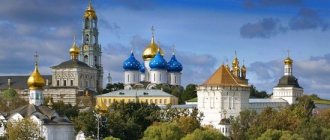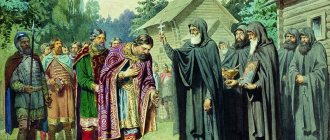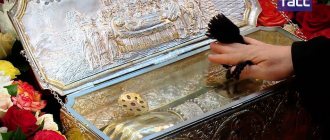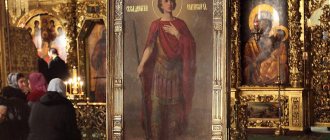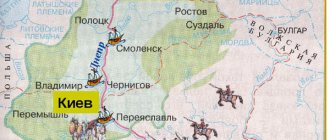The author of the publication “Falsehood and Falsehood,” Alexander Melenberg, analyzes monuments of ancient Russian writing that reflect the events of 1380 (the so-called special block of “works of the Kulikovo cycle”):
The victory on the Kulikovo Field is, of course, one of the most significant events in history Russia. Like any phenomenon of this magnitude, over the years it began to be accompanied by all sorts of speculations, additions, “new details”, usually invented with good intentions. At some point, such virtual facts suddenly come to the fore, becoming not just a historical cliche, but an immutable truth. In the history of the Battle of Kulikovo, this kind of “truth” is also found.
The first of them in terms of the time of writing are the article of 1380 by the Rogozhsky chronicler and the article of 1380, similar in content to it, by the Simonov Chronicle. According to experts, both of these sources were included in the chronicle of 1409, that is, they were read by contemporaries of the Battle of Kulikovo. What is the value! So, when describing the preparation for the campaign and the battle itself, the name of Sergius of Radonezh is not mentioned there at all. Consequently, there is no question of any blessing of the Grand Duke by him.
.
The second oldest surviving evidence of the events of 1380 is conveyed by the 1st Novgorod Chronicle. Experts also consider it to go back to the code of 1409, in the sense that it was the primary source for the Novgorod author of the chronicle. The Novgorod 1st Chronicle itself appeared in the chronicle code of 1448, therefore, it was created in the 40s. XV century. More than 6 years have passed since the Battle of Kulikovo. There were practically no living witnesses to this grandiose event; at least, they could be counted on one hand.
And here Sergius of Radonezh is not mentioned at all.
At the same time, the Novgorod author reports an interesting fact that could not have seen the light of day in the previous narratives of Moscow authors: just before the battle, when the Russians entered the Kulikovo field and saw the Tatar army against them, ready for battle, their first reaction was panic, many recruits from the Moscow regiments rushed to flee... But then the chronicler pays tribute to Grand Duke Dmitry Ivanovich and Prince Vladimir Serpukhovsky, who abruptly stopped the panic in the ranks of their soldiers and quickly put them in a fighting mood.
The third most recent story about the Battle of Kulikovo found a place on the sheets of the 1st Sofia and (with almost similar text) the 4th Novgorod Chronicle. Both of them go back to a common protograph - the Novgorod-Sophia arch of the 30s. XV century But at the same time, the manuscript of the 1st Sofia Chronicle is dated by specialists to 1481. At least, it was completed in this year. The original Novgorod 4th is even later. It is clear that there is no need to talk about any living witnesses to the battle of 1380.
A hundred years have passed, and the name of Sergius of Radonezh is mentioned for the first time in the chronicles.
.
But not at all in the context in which current apologists associate him with Kuliki: “And then a letter arrived from the venerable abbot Sergius from the holy elder, blessed
.
But there was no such touchingly now described visit by Grand Duke Dmitry, the future Donskoy, to the Trinity-Sergius Monastery in August 1380 and his receipt of personal blessings and parting words from the abbot, Elder Sergius, in the chronicle source. And there was a written wish for good luck (if you went, then go to the end, and may they help you...)
, which arrived on the Don on September 6, 1380, two days before the battle.
All of the above-mentioned works of the Kulikovo cycle relate to the subject of history, but the next monument in the cycle is literature. "Zadonshchina"
- a poetic work based on the motif and style of “The Tale of Igor’s Campaign.” The authorship of this work is associated with the name of Zephanius of Ryazan. The name of Sergius of Radonezh is not mentioned there at all.
On the oldest list of “Zadonshchina” there are marks of either the author or the copyist, the dates: 1470, 1475, 1483. and even an indication that on September 8, 6988, the Battle of Kulikovo “100 years had passed.” That is, for the reader the plot is covered, if not with a haze of fog, then with a certain veil of a long past time. Like the Russian-Japanese War for us. And readers of the late 15th century. They knew, of course, about the fact of the Battle of Kulikovo, but the details were no longer available to them.
Another period of time passed, and on the basis of the “Zadonshchina” at the beginning of the 16th century. a prosaic literary text “The Tale of the Massacre of Mamayev” appeared
.
Here the author already introduces a lot of fantasies and new collisions into the plot, helping to maintain intrigue in his novel. This is where Sergius of Radonezh already blesses Dmitry Donskoy in full:
both verbally in the Trinity Monastery and in writing on the Don.
This is where everyone who now speaks passionately about the great old man’s blessing of the Grand Duke draws inspiration from.
Agree, in everyday life it looks quite strange and even absurd to try to take episodes of a literary plot at face value, and even earnestly convince others of this.
With the light hand of Karamzin, the thesis about the spiritual participation of Sergius of Radonezh in preparing the campaign against the Tatars was established. He literally wrote the following lines: “...Dimitri, having arranged the regiments for the march, wanted with his brother Vladimir Andreevich, with all the princes and governors, to accept the blessing of Sergius, abbot of the distant Trinity Monastery... Chroniclers say that he predicted terrible bloodshed for Dimitri, but victory - death many Orthodox heroes, but the salvation of the Grand Duke; He begged him to dine at the monastery, sprinkled holy water on all the military leaders who were with him, and gave him two monks as associates, Alexander Peresvet and Oslyabya, of whom the first was once a boyar of Bryansk and a courageous knight. Sergius handed them the sign of the cross on the schema and said: “Here is an incorruptible weapon! May it serve you instead of helmets!..”
From the above it is clear that the relationship between Dmitry Donskoy and Sergius of Radonezh, which developed before the Battle of Kulikovo, was not such as to ask for and receive a blessing. In the XIV century. this was clear to everyone. But the XV and XVI centuries. the need arose to impose a sacred sanction on the actions of secular power. Whether this was connected with the completion of the collection of Russian lands and the development of the idea of “Moscow - the third Rome” or with the final liberation of the Tatars from power is now difficult to say. However, it is clear that the emergence of the legend about the blessing of Dmitry by St. Sergius is a vivid example of great state PR, which continues to work successfully today.
Criticism of criticism
Do the arguments of the “critics” camp sound solid? Oh yes, they are impossible to ignore. But each of them, upon closer examination, looks quite controversial. It makes sense to go point by point, showing the weaknesses of each.
Battle of Kulikovo. Miniature from “The Life of Sergius of Radonezh” (XVII century, Russian State Library)
First of all, in 1380 Dmitry Ivanovich made peace with Cyprian. A few months after the victory over Mamai, the Grand Duke, according to the chronicle, “sent Hegumen Fyodor Simanovsky, his spiritual father, to Kyiv as Metropolitan Cyprian, inviting him to Moscow to join him as Metropolitan.” The chronicle of Cyprian's movements throughout Rus' for 1380 is not known. He, like Pimen, visited Constantinople, after which both returned to Rus'. Cyprian could overtake Pimen and visit Moscow. Even if Cyprian did not reach Moscow, he could enter into correspondence with the Grand Duke and the Moscow clergy, and traces of this correspondence were conveyed, in an altered form, by “The Tale of the Massacre of Mamaev.” In any case, the quick reconciliation immediately after the victory over Mamai shows: most likely, some kind of negotiations between him and Dmitry Ivanovich were conducted even before it; a meeting between them is not so impossible, and the establishment of good relations is very likely.
But in 1378, no dialogue was possible: the “Mityaevism” was in full swing.
Could Sergius bless a ruler who had cruelly offended the Church? Yes, it would be strange to refuse a blessing to the head of the Christian army, going to drink the mortal cup! In fatal moments, only an insignificant person begins to nurse and cherish previous grievances. Is it appropriate to dress St. Sergius in the garb of a nonentity?!
There is no information about the sending of two monks with the Grand Duke in the “Life” ... since no one obliged the compiler of the “Life” to include them there. One cannot expect accuracy from such a monument. This is not a chronicle!
It is inappropriate for monks to fight in mortal combat. However, this is not yet a reason to deny the authenticity of the “Tale...” In the earliest, most reliable chronicle narration of the events of 1380, Alexander Peresvet is named among the noble people who fell on the field. Another chronicle calls him a former Bryansk boyar. It turns out that the hero of the duel with Chelubey was still present in the Russian army. And he did not pray behind the wall of warriors, but he himself fought with the Horde. Nowhere, in any place, is he called a “metropolitan boyar.” But he could well have been a novice at the Trinity Monastery.
In other words, Peresvet and Oslyabya at the time of the Grand Duke’s visit to Sergius may not have yet taken monastic vows, which means they could temporarily throw off their cassocks to put on chain mail.
They also assume something else. In the conditions of the “holy war”, on which the fate of Rus' and Russian Orthodoxy depended, Peresvet could lay down his soul for the sake of his brothers, committing a clear violation of his vows. People are capable of a lot in extreme conditions...
As for the “Christ-loving army” sprinkled by Sergius, no absurdity or inconsistency is visible here either. The “Tale ...” does not say at all that the Grand Duke brought with him the entire Moscow squad, and especially all the Russian regiments, to Sergius. But he and Prince Vladimir Andreevich were accompanied by an armed retinue. It was this that the author of the “Tale…” called the Christ-loving army. The main forces at that time did not move from the capital, waiting for Dmitry Ivanovich.
Is the “Legend…” as a whole a late source? Yes, most likely, that's exactly it. But not so late that it could not reflect the memories of the participants in the battle, carefully preserved by their descendants. In addition, its author could have used much earlier chronicles that have not survived to this day.
It remains to conclude: indeed, “The Tale of the Massacre of Mamayev” raises many questions. Including a plot related to the blessing of Sergius. Some of them cannot be answered with strict certainty: historians do not have a time machine, they can only judge ancient times from texts that have survived to this day... And the texts are not always crystal clear. The answers voiced by the “critics” are in themselves just reflections on the more or less probable course of events in 1380. The hypothesis behind them looks weaker than the traditional point of view in many respects.
In short, there is no reason to discount “The Tale of Mamaev’s Massacre” once and for all.
What not to do on June 1, Memorial Day of Dmitry Donskoy
On this day we remember not only the name of Dmitry Donskoy, but also all the deceased soldiers who gave their lives for the faith and the Fatherland. Therefore, the Church holiday involves observing a number of prohibitions:
1. Do not quarrel with relatives and friends who are related to military service. Otherwise you will bring trouble on yourself.
2. Don’t do general cleaning, don’t start moving, and put off repairs and household chores for another day.
3. Do not deal with financial problems and do not ask for financial help (you can bring trouble not only on yourself, but also on the one who will help you).
It is also undesirable to cut hair, nails and visit beauty salons. And this recommendation does not only apply to women.
The main achievements of the reign of Dmitry Donskoy:
• The unification of Russian lands with the center in the Moscow Principality.
• Victory over the army of Mamai in the Battle of Kulikovo, which became the first step towards the liberation of Russian lands from the dependence of the Golden Horde. By 1370, mutual understanding between Rus' and the Horde yoke had completely deteriorated. This was facilitated by the strengthening of the Russian principalities, ready for confrontation. When Prince Dmitry refused to pay the Horde exit (tribute), the military leader of the Tatar-Mongol yoke Mamai gathered troops for a new campaign against Rus' in order to bring the obstinate ruler to reason. But in the end he suffered a crushing defeat in the Battle of Kulikovo, which resulted in the merger of the Vladimir and Moscow principalities.
• Construction of the first stone fortress on the territory of Moscow - a white stone Kremlin instead of the old wooden one.
The heir to the Rurik dynasty received his nickname “Donskoy” after the victory in the Battle of Kulikovo.
The noble prince departed to the Lord on May 19, 1389. The relics of Dmitry Donskoy are kept in the Archangel Cathedral of the Kremlin.
Canonized in 1988, the year of the celebration of the millennium of the baptism of Rus'.
